Public Archaeology at the Presidio of San Francisco
By Edward De Haro and Claire Yancey
Archaeological excavation of the Spanish Colonial fort of El Presidio de San Francisco started in early May 2014. They revealed archaeological deposits with artifacts and features dating to the Spanish, Mexican, and American occupations of the area. It is the biggest public site of its kind west of the Mississippi. Our open site approach allows visitors to talk directly to archaeologists and ask questions as they witness excavation first hand. Docents are available to give overviews on the history of the Presidio. They answer general questions about archaeology and the goals of the excavation.
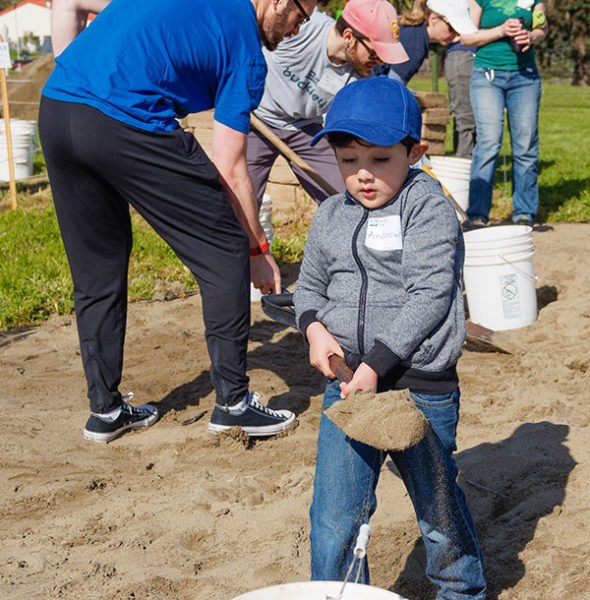 At the Presidio Archaeology Lab, much of our work relies on the help and dedication of our volunteer community. The volunteer program was conceived well before the El Presidio de San Francisco excavations began. We currently have a pool of 225 volunteers who have undertaken training in the proper handling and processing of artifacts and lab techniques. This group helps us in the lab throughout the field season. They participate in a variety of tasks both indoors and out. Our mailing list now exceeds 500 interested individuals, and we get more sign ups every day.
At the Presidio Archaeology Lab, much of our work relies on the help and dedication of our volunteer community. The volunteer program was conceived well before the El Presidio de San Francisco excavations began. We currently have a pool of 225 volunteers who have undertaken training in the proper handling and processing of artifacts and lab techniques. This group helps us in the lab throughout the field season. They participate in a variety of tasks both indoors and out. Our mailing list now exceeds 500 interested individuals, and we get more sign ups every day.
As our volunteer program has grown, we’ve continued to seek opportunities to create a program that is not only beneficial to our lab and the work that we do, but also supports and encourages the interests and hard work of our volunteers. Each year, we hold two bookend events. The first, Back into the Earth Day, signifies our return to the earth and the launch of the season by exposing our units from the previous years. International Archaeology Day is our end-of-season open house. We invite the public to see all aspects of our work and what we discovered during the field season.
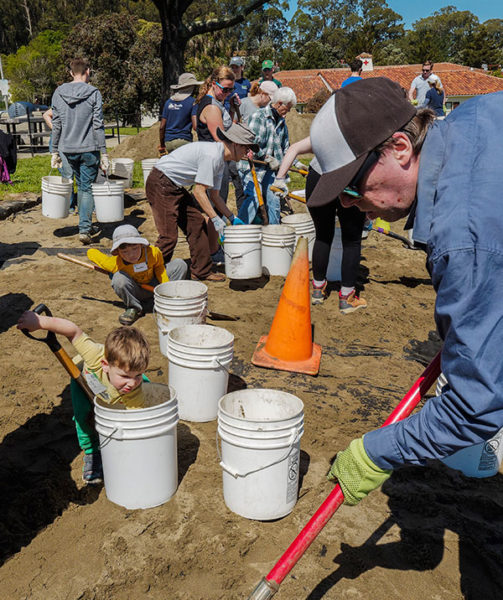
Back into the Earth Day is a day to reconnect with our docents and volunteer community after a winter hiatus and is a fun hands-on way to introduce archaeology to the curious public. The Presidio Archaeology Lab is dedicated to public archaeology and tries to offer multiple opportunities for park visitors to be exposed to archaeology and its significance. Back into the Earth Day is the one day each year that we invite the general public to step into our units for a day and “dig” alongside us.
On Earth Day 2018, Saturday, April 21st, volunteers ranging from the young to the not-so-young helped us to remove the sand fill used to protect the archaeological site during the offseason. A total of 162 volunteers made short work of the majority of the sand. Volunteers alternated between shoveling sand and emptying buckets – quite a task! Throughout the day we had curious onlookers step onto the site to ask questions and take pictures. Quite a few even decided to join the fun! The day finished with a BBQ and socializing at the outdoor lab area situated only a short walk from the site.
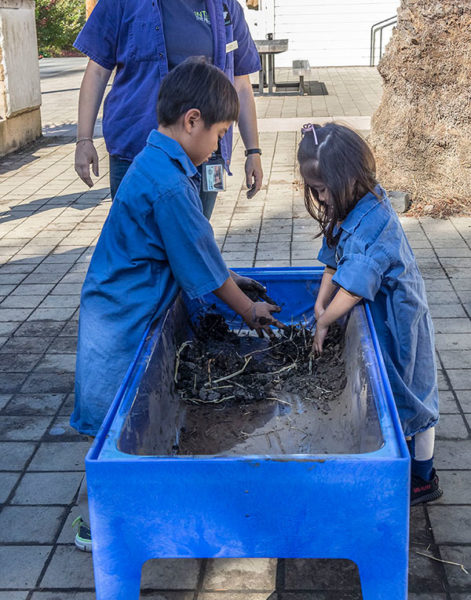 At the end of the season, in October, we hold our second bookend celebration that is coordinated with other International Archaeology Day events throughout the world. We open our lab and collections facility, in addition to the site, encouraging the public to get a behind the scenes look at what we do. This event is youth-oriented, with educational games, puzzles, scavenger hunts, adobe brick making, and many more activities. International Archaeology Day is also a reunion of sorts, with many former volunteers, interns, and team members returning to reconnect with each other before the site is closed for the winter. The 2017 event saw us welcome over 300 visitors of all ages, and we expect even more this year! After our celebrations, the site is again covered in landscaping fabric and backfilled with locally-sourced sand until it is unveiled again in April for Back into the Earth Day. These events are incredibly popular and are great ways to acknowledge our volunteers, but we are constantly on the lookout for ways to improve our program and to honor our volunteers throughout the year.
At the end of the season, in October, we hold our second bookend celebration that is coordinated with other International Archaeology Day events throughout the world. We open our lab and collections facility, in addition to the site, encouraging the public to get a behind the scenes look at what we do. This event is youth-oriented, with educational games, puzzles, scavenger hunts, adobe brick making, and many more activities. International Archaeology Day is also a reunion of sorts, with many former volunteers, interns, and team members returning to reconnect with each other before the site is closed for the winter. The 2017 event saw us welcome over 300 visitors of all ages, and we expect even more this year! After our celebrations, the site is again covered in landscaping fabric and backfilled with locally-sourced sand until it is unveiled again in April for Back into the Earth Day. These events are incredibly popular and are great ways to acknowledge our volunteers, but we are constantly on the lookout for ways to improve our program and to honor our volunteers throughout the year.
Throughout the season, volunteers help wet screen in the outdoor lab and sort and process artifacts in the indoor lab. Over the years, with a combination of surveys, individual suggestions, and in-person conversations, we have been able to craft a program that is not only beneficial to the lab, but also cultivates a feeling of ownership and agency for our volunteers. Based on this ongoing feedback, we are able to create special programs and engaging events that often reach a wide range of age groups and communities. These programs and our research excavation would not be possible without our community of volunteers and docents.
One such suggestion from volunteers resulted in after hours workshops geared towards learning the finer details of archaeology and research. These workshops will cover ceramic types, zooarchaeology, glass identification and manufacturing techniques, and more topics still in the works. Eventually, we hope to partner with outside institutions to expand our offerings by inviting guest speakers and specialists.
As we move forward, we are seeking more ways to improve or expand the program without sacrificing the quality of our offerings and overtaxing our staff. We will look towards our volunteers and listen to their ideas on what could be improved, or removed, and make the necessary adjustments. They allow us to meet our goals in interpretation, investigation, and education.
So, as we embark on our fifth season, we remind ourselves that we are not only a team of archaeologists, but a community that reaches well beyond the limits of the park.
Disappearing Heritage
Disappearing Heritage
Haley Streuding
Coastal Environments, Inc.
As a member of the Society of Historical Archaeology’s newly-formed Heritage at Risk Committee, I am interested in creating a dialogue – or at least being a part of the dialogue – on how climate change affects archaeological sites around the country, and what we as archaeologists can do to protect these sites.
Climate change has impacted cultural resources either directly or indirectly for some time, but this issue has gained traction only recently. It has become painfully clear that many sites, particularly those in coastal areas, are in danger of disappearing forever. In fact, I have seen the end result of years and years of climate change wreaking havoc on our heritage. Several years ago, I worked as an archaeological monitor for the National Park Service during the BP Oil Spill cleanup. The cleanup effort took place on the Mississippi Barrier Islands (Cat Island, East and West Ship Island, Horn Island, and Petit Bois Island). In the early part of the twentieth century, there was another small island, called Dog Island. Dog Island (later renamed the Isle of Caprice) was not a true barrier island, but rather a developing shoal created from the merging of several small ephemeral sand keys known locally as the “Dog Keys.” The island became the site of a bustling resort and casino between 1926 and 1930. However, the resort’s success was cut short in 1931, when the sediment required to nourish the island began to diminish. Without this nourishment, the island slowly began to erode in response to the normal effects of winds, waves, and tides. By 1931, the island was reduced to a sand bar devoid of dunes and vegetation, and a year later it was completely submerged. Although it is difficult to attribute the disappearance of the island to climate change, as it succumbed to natural processes, I firmly believe it had a hand in it. The rapidity of the site’s demise got me thinking: How many other sites have been lost, swallowed up by the Gulf?
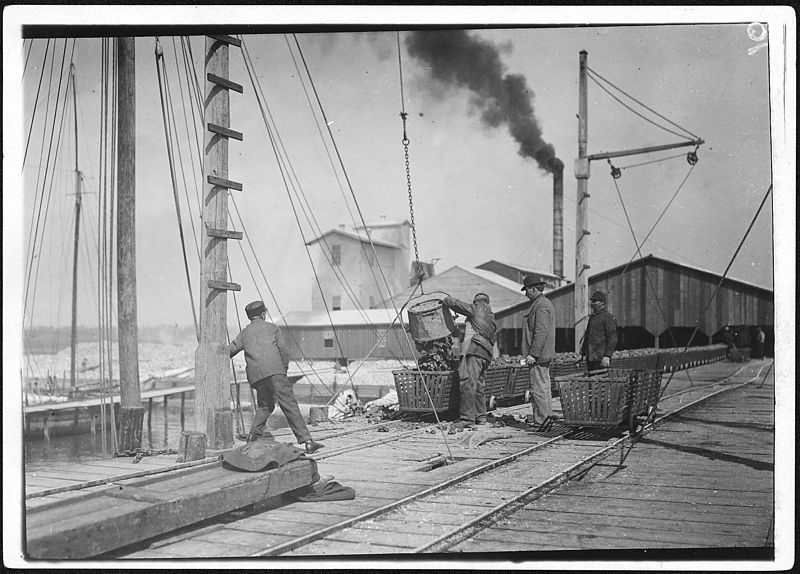 Unloading oysters at the Alabama Canning Company factory wharf in February 1911 (Anonymous 2018 [1911]).
Unloading oysters at the Alabama Canning Company factory wharf in February 1911 (Anonymous 2018 [1911]).
Since I am a coastal Mississippi native, my primary focus is on archaeological sites located along the Gulf Coast. Initially, I wanted to discuss in general the affect climate change has had on these sites; however, as it happens, I recently worked on a survey project that involved this very issue. The survey, which entailed both a terrestrial and marine component, was for a proposed shoreline protection and marsh restoration project by the Nature Conservancy in the small, coastal town of Bayou La Batre, Alabama. As with any project, I began conducting background research to locate any cultural resources that existed in the area. This research led to the identification of a historic site that had not been recorded previously. This site consists of building remnants scattered along approximately 150 meters of shoreline. Some of the remnants were located in the water, undoubtedly the result of decades-long erosion and severe storms. The site turned out to be the old Alabama Canning Company, which was an oyster cannery in operation during the early-twentieth century.
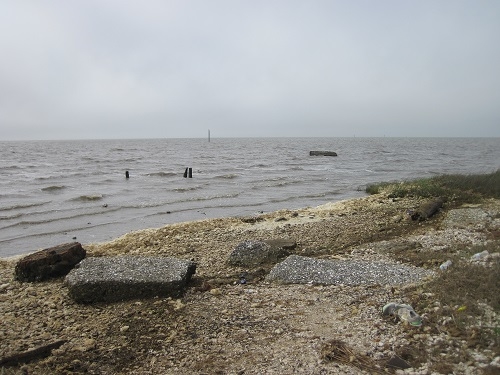 Concrete blocks observed on the surface at the cannery site. Note the inclusion of shell in the concrete. Photo by Philip Jungeblut.
Concrete blocks observed on the surface at the cannery site. Note the inclusion of shell in the concrete. Photo by Philip Jungeblut.
The historic site clearly had suffered from the effects of climate change. Storms have torn the structures apart, and much of it is partially submerged by the waters of Portersville Bay. It is likely the site will disappear completely in the near future. As I was writing the report of the survey results, I pondered how to preserve this part of history. Typically, I would recommend avoidance, so it would not be disturbed any more than it already has been. However, avoidance does not really solve the problem of disappearing heritage on coastal sites. Of course, a data recovery phase of excavation would be ideal, but limited funding renders this option unfeasible. As it turns out, the proposed shoreline protection and marsh restoration project may ultimately preserve the site. Dredge spoil deposition will result in shoreline stabilization and probable sediment accretion over and across the site. Sediment accretion may work to halt further structural degradation and may in fact aid in in situ preservation.
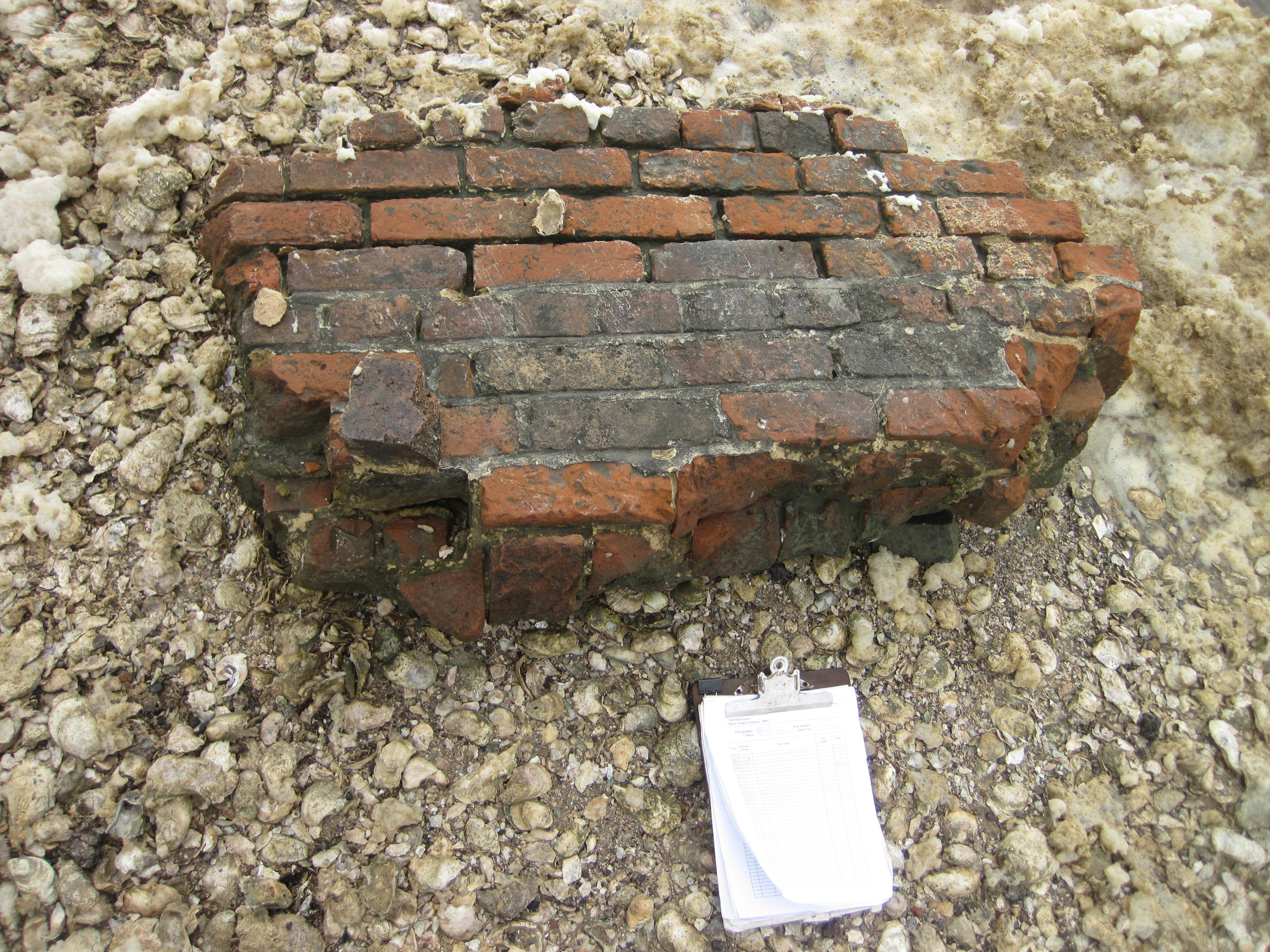 Part of a brick wall observed at the cannery site. Photo by Philip Jungeblut.
Part of a brick wall observed at the cannery site. Photo by Philip Jungeblut.
While the above action may help to preserve the cannery site, it may not work for others. Archaeological sites are unique, and the issue of preservation should be handled on a site-by-site basis. So, how do we protect cultural resources when every site is different? I believe communication is the key. Archaeologists, professional and amateurs alike, should talk to one another. Share our experiences, problems, and solutions. Additionally, we should engage the public. By getting communities involved, we are exposing more people to the topic of how climate change affects archaeological sites. Maybe with enough boots on the ground, we can find a way to save these sites and ensure the survival of our heritage.
New Thematic issue of Historical Archaeology on ‘Labor and Plurality in the Northeast’
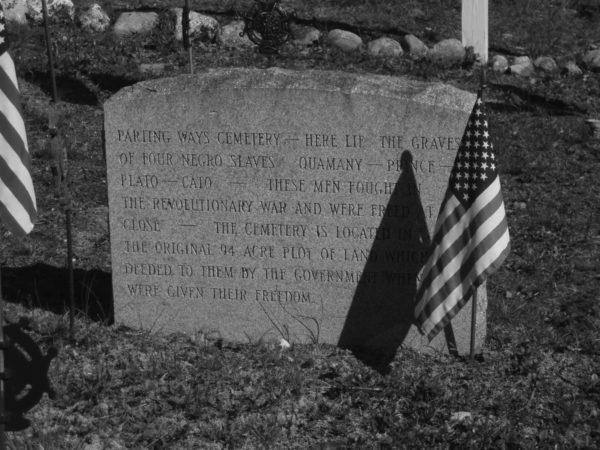
The next issue of Historical Archaeology will arrive in your mailbox in the new few days! Issue 52(1) is the first to combine a thematic collection with other content including research articles, technical briefs, memorials, and reviews. This opportunity to publish more content in each issue is a welcome benefit of our publishing relationship with Springer. It will cut down on our past delays in publishing accepted articles, allowing HA readers to keep up to date on current research. The following is a brief description of the thematic collection from guest editor Bradely D. Phillippi.
We are pleased to present a new thematic collection of articles in Historical Archaeology entitled “Labor and Plurality in the Northeast.” The collection revisits the familiar topic of plural archaeological contexts but problematizes the concept by acknowledging the material vagaries they produce. Working with ambiguous assemblages devoid of the traditional markers of identity in shared spaces, writers collectively work to recover those muted by historical circumstances of plurality and conventional readings of their material lives. Accordingly, authors recover and render the past in ways that emphasize working class families, indigenous Americans, enslaved and free people of color, and descendants of mix-heritage households, each victimized by peculiar impositions privileging some and subordinating others. Analytically prioritizing labor systems and relations of production, rather than culture, binds this collection together. Although exploratory, case studies convincingly identify and read various aspects of labor in ways that parse out diversity from ambiguous and seemingly homogenous assemblages.
The collection includes case studies from the American Northeast. Organized by scale of analysis, settings gradually narrow from macro treatments of labor and plurality at the regional scale down to refined considerations of individual households. Following the introductory essay, “Introduction: Labor and the Challenge of Plurality in Historical Archaeology,” by Bradley Phillippi, articles in the forthcoming issue include:
* Markers of Difference or Makers of Difference?: Atypical Practices at Haudenosaunee (Iroquois) Satellite Sites, ca. 1650-1700—Kurt A. Jordan
* Created Communities: Segregation and the History of Plural Sites on Eastern Long Island, New York—Christopher N. Matthews and Allison Manfra McGovern
* Survivance Strategies and the Materialities of Mashantucket Pequot Labor—Russell G. Handsman
* Modernity and Community Change in Lattimer No. 2: The Archaeology of the American 20th Century through a Pennsylvania Anthracite Shanty Town—Michael P. Roller
* The Plurality of Parting Ways: Landscapes of Dependence and Independence and the Making of a Free African-American Community in Massachusetts—Karen A. Hutchins-Keim
* Homeplace is Also Workplace: Another Look at Lucy Foster in Andover, Massachusetts—Anthony Martin
* Muffled, But Not Mute—Bradley D. Phillippi
* Laboring Under an Illusion: Aligning Method and Theory in the Archaeology of Plantation Slavery—Anna Agbe-Davies
The image is of the monument at the site of Parting Ways commemorating the lives of Plato Turner, Cato Howe, Prince Goodwin, and Quamony Quash. Photo by Karen A. Hutchins-Keim, 2011.
Introducing the Heritage at Risk Committee!
Hello all. It’s my pleasure to introduce the newly-formed Heritage at Risk Committee (HARC).
[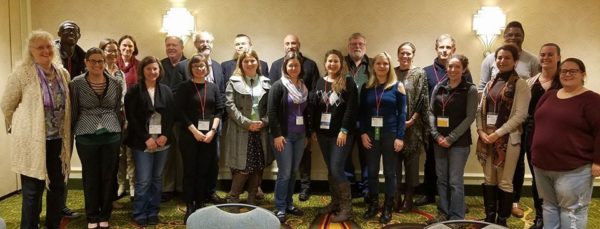
Our first meeting was held during SHA conference in New Orleans last month, after the committee was established by Past President Joe Joseph at the mid-year meeting in June. We were delighted to see 24 members in attendance – almost half of the over 50 SHA members who have joined the committee! – and to engage in stimulating discussion about our present and future goals.
The committee was formed to promote heritage at risk research and outreach within SHA, including the development of resources for use by the membership, and to disseminate information to the public about climate change’s impacts to archaeological sites. A few of HARC’s key goals include increasing advocacy efforts at the national and international levels, promoting expansion of heritage at risk themes at the annual conference, and increasing collaboration both with other committees within SHA and with professionals outside of the membership who study the impacts of climate change on our shared cultural resources.
Short-term projects discussed at the meeting include the development of a pop-up exhibit highlighting case studies within SHA to build resources for the membership, as well as opportunities for HARC involvement at the 2019 meeting to be held in St. Charles, Missouri. These opportunities include: 1) a case studies/best practices symposium, 2) a policy and regulatory session, and 3) a panel addressing climate change by going beyond science to engage the arts and humanities. Longer-term goals include the development of publications within SHA by HARC members. The meeting closed with each member contributing suggestions for future directions and additional topics to address.
If you were unable to make it to the first Heritage at Risk Committee meeting but would like to participate, please contact the HARC Chair Sarah Miller at SEMiller@flagler.edu.
If you see an interesting article about climate change and/or other heritage at risk themes from which you feel the SHA membership could benefit, please send me a link! I can be reached at:
Valerie M. J. Hall
Social Media Liaison, Heritage at Risk Committee
I hope to hear from you soon!
New UNP-SHA Publication and Author Perspective
Submitted by Rebecca Allen
Environmental Science Associates (ESA), Cultural Resources Director
SHA Associate Editor
In 2011, the University of Nebraska Press and the SHA jointly published the first of the Historical
Archaeology of the American West Series. Annalies Corbin and I are series editors, and over the course
of this year, we will be contributing to the SHA blog to highlight authors in this series. The primary goal
of SHA’s co-publication program is to expand our membership’s publication opportunities, and find
more partners to promote our field. UNP publishes many titles in American Studies, Anthropology,
History, and Native American and Indigenous studies. The press regularly exhibits at western regional
and national history conferences, bringing the topic of historical archaeology to a wider audience.
Take advantage of the discount to order your copies of new volumes by Jun Sunseri and Chris Merritt.
On behalf of the SHA, I’d like to thank these authors, as all royalties in this series return to SHA
publications, to fund future studies. And please contact me (rallen@esassoc.com) if you are interested
in contributing a volume in this series.
ABOUT THE BOOK
Situational Identities along the Raiding Frontier of Colonial New Mexico
Jun U. Sunseri
240 pages
3 photographs, 39 graphs, 5 maps, 16 illustrations, 4 tables, index
Situational Identities along the Raiding Frontier of Colonial New Mexico examines pluralistic communities that navigated between colonial and indigenous practices to negotiate strategic alliances
with both sides of generations-old conflicts. The rich history of the southwestern community of Casitas
Viejas straddles multiple cultures and identities and is representative of multiple settlements in the
region of northern New Mexico that served as a “buffer,” protecting the larger towns of New Spain from
Apache, Navajo, Ute, and Comanche raiders. These genízaro settlements of Indo-Hispano settlers used
shrewd cross-cultural skills to survive.
Researching the dynamics of these communities has long been difficult, due in large part to the lack of
material records. In this innovative case study, Jun U. Sunseri examines persistent cultural practices
among families who lived at Casitas Viejas and explores the complex identities of the region’s
communities. Applying theoretical and methodological approaches, Sunseri adds oral histories,
performative traditions of contemporary inhabitants, culinary practices, and local culture to traditional
archaeology to shed light on the historical identities of these communities that bridged two worlds.
AUTHOR INTERVIEW
RA: What are some of your motivations for writing this book?
JS: Discussions with my colleagues, the SHA co-publication editors, and editors at UNP reminded me that
this story that I first addressed in my dissertation was truly worth re-working and re-telling, and they
helped me bring it alive. In more ways than I can count, the opportunity to work closely with the
descendant community and a rich network of scholars on this project was rewarding and truly affirming of why I left engineering for archaeology. I am hoping to share some of that energy and the nuances of
the story with a wider audience.
RA: Who would you like to read this book? Who is your audience?
JS: First and foremost, this book is dedicated to the descendant community and the places and people
who guided, protected, and sacrificed to bring the work to fruition. It is incredibly gratifying to hear that
advance copies are already being read enthusiastically and handed from person to person there. I am
also hoping that communities who are also struggling with land and water rights, for whom archaeology
has not always been a service or a resource, might be inspired to connect and build coalitions with each
other.
RA: Now that you have published this book, what kinds of things are you dreaming up next? What is in
the works?
JS: I’ve already been asked to present with community partners about this book this fall in New Mexico
and we are looking forward to building momentum on a number of issues related to this work. Other
villages in New Mexico have asked for partnerships related to these kinds of complex cultural
patrimonies. I might change gears for a little while and concentrate on method and theory a little more,
specifically issues of labor and scales of economy related to butchery and other human-animal
interactions.
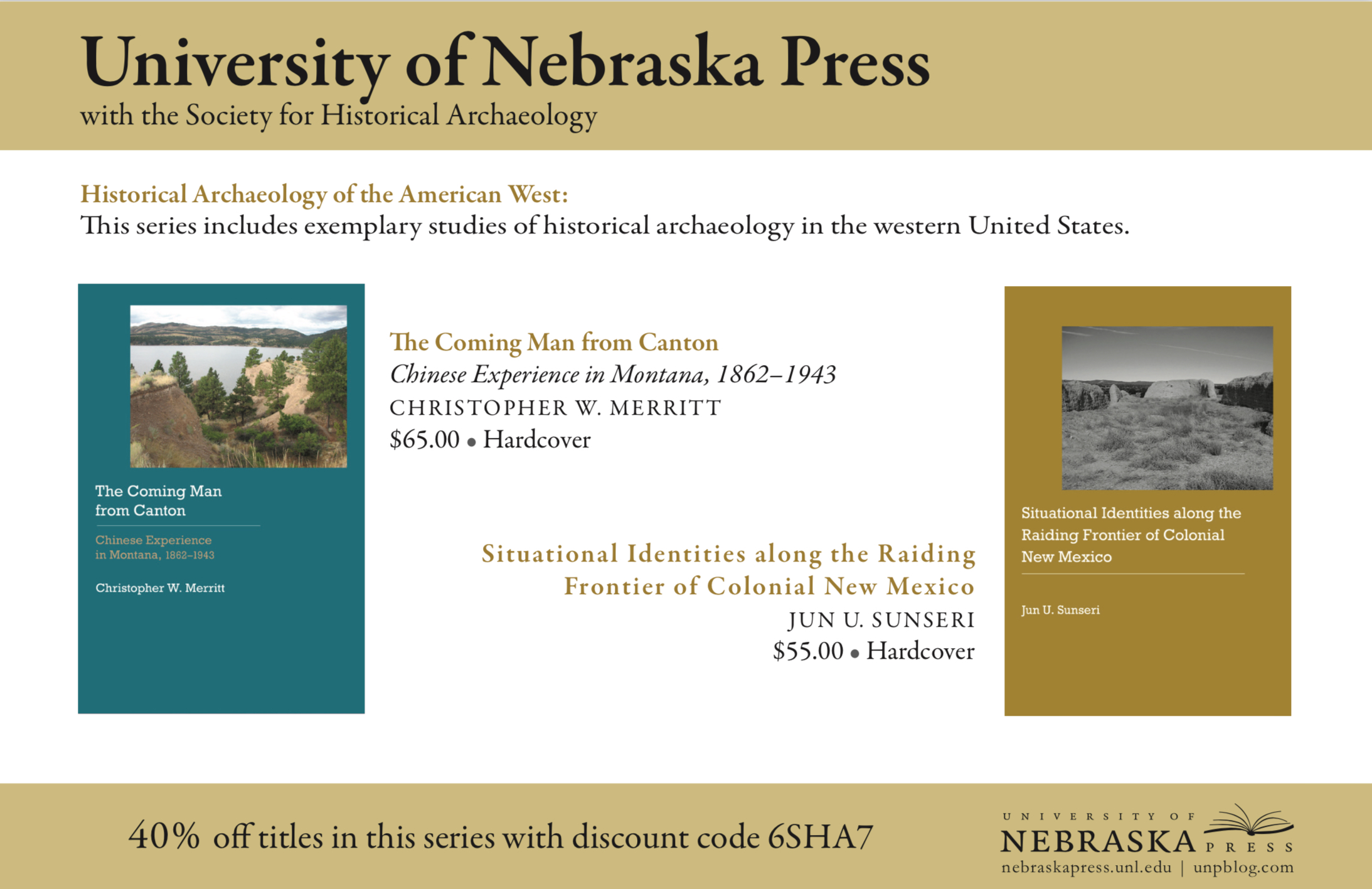
Ceramics Identification is Clear as Mud
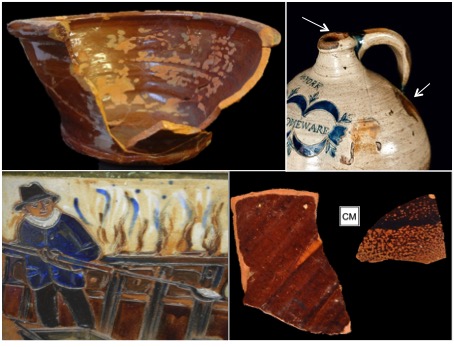
Collage of earthenware and stoneware images.
When I (Lindsay) first started visiting archaeological collections from historic kiln sites in the mid-Atlantic for my dissertation research, I found time and again that the same researcher had already been there: Brenda Hornsby Heindl. We eventually met, and learned that we had distinct but complementary interests in these collections. Brenda is a stoneware potter, and has focused her recent research on historic kiln and ceramic production technology. I research coarse earthenware production and trade in the Atlantic World. In other words, we love to get very technical about clays, kilns, and all things pottery-related! At this year’s SHA annual meeting, we led a workshop that had been several years in the making, “Clear as Mud: A Toolkit for Identifying Coarse Earthenwares and Stonewares.”
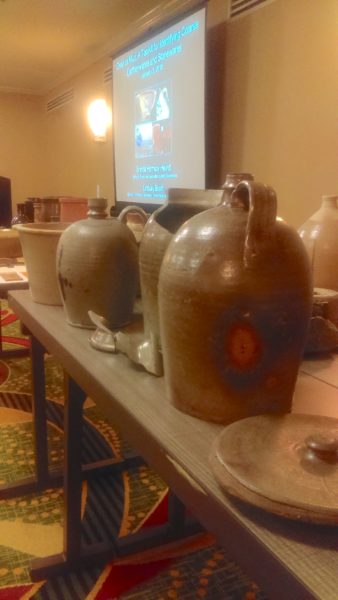
Table of stoneware examples.
This workshop idea arose because both of us have been frustrated by the issues plaguing coarse earthenware and stoneware identification in archaeological collections. These wares are ubiquitous, and superficially share a number of characteristics. Yet at the same time, as handmade items, each varies in ways that may seem random to the casual observer. These wares also tend to lack the defined date ranges we have come to expect for most historic ceramics. For these reasons, many archaeologists fall back on general categories such as “American Stoneware” or “Redware,” lumping sherds into large groups that are not very useful analytically. After years spent digging through boxes of wasters and kiln furniture from pottery production sites, and many hours spent with microscopes, mass spectrometers, and pottery wheels, we have come to recognize some key patterns for earthenware and stoneware identification. Generally there is no single attribute, but a constellation of attributes that together are diagnostic.
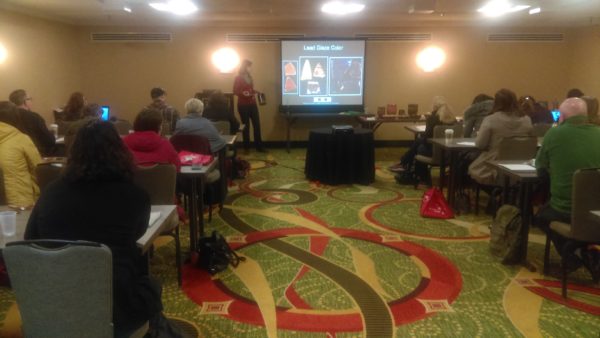
Lindsay lecturing on lead glazes.
Our goal in this workshop was to train participants to recognize the characteristics that are meaningful markers of production method and source. Attributes like firing cores and glazing patterns can be tied to specific production practices that may have temporal, geographic, or ethnic connections. Better identification of these wares has a big payoff for research, from improved mean ceramic dates (MCDs) and site chronologies, to providing evidence for trade at all levels, from very local to global.
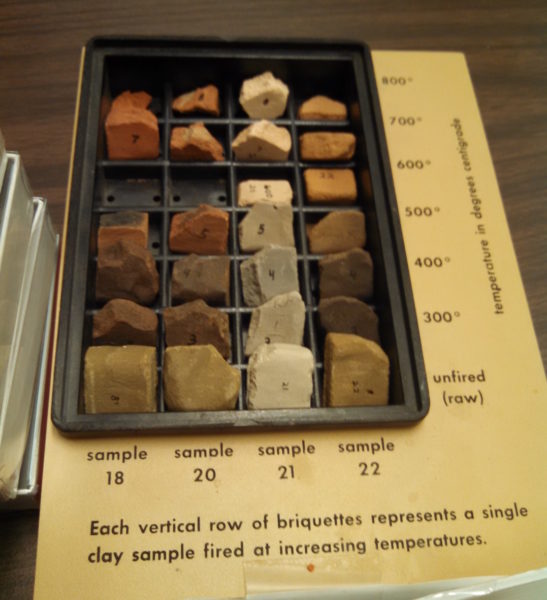
Earthenware briquettes, illustrating how temperature affects color, texture, and density.
It was important to us that the participants learned as we did, by being able to handle and study a variety of broken and complete pots. So, we packed up our study collections and brought the many boxes with us to New Orleans. The four-hour workshop toggled between lectures and hands-on activities. We provided each table with a pile of sherds representing different ware types, vessel forms, and sources. Participants sorted these in various ways, as they learned about kiln firing temperature and atmosphere, surface treatments and vessel form. At the front of the room we laid out a table of earthenware vessels and a table of stoneware vessels, each piece illustrating different technological and origin markers. We also set up a digital microscope with mounted sherd cross-sections, to show how characteristic aplastic inclusions could point to a vessel’s source.
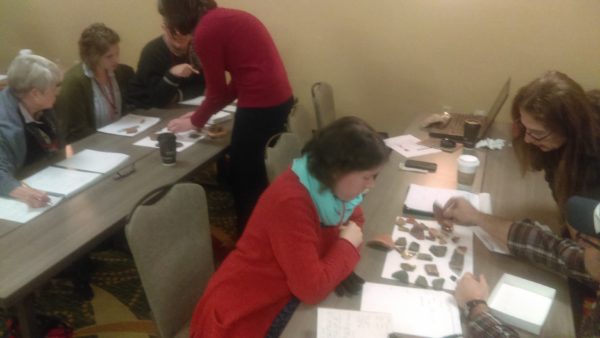
Participants at work sorting sherds.
While the conditions in the conference room were arctic, feedback from the workshop has been very positive. In the post-workshop survey, responses have been evenly split between those who found the lectures most useful, and those who learned more from the hands-on activities, with several responses valuing both equally. We recognize that many archaeologists are working with limited study collections or without access to identified materials. Online galleries are great, but they can’t substitute (yet) for the tactile and three-dimensional nature of the objects themselves. The “emery board” texture of London-area redware, the gleam of a well-salted Westerwald stoneware are difficult to capture in pictures. As archaeologists we need more opportunities to handle unfamiliar artifacts and share diagnostic materials. In this brief experience, we only introduced a small fraction of the body of knowledge to be gained from these artifacts. However, we hope that some of our participants now agree that “clear as mud” doesn’t have to be an oxymoron when it comes to historic pottery production. The answers are written in the clay.
If you want to really understand the handmade pottery in your collections, we recommend the following:
- Keep a microscope on hand for ceramics analysis. Pay attention to inclusions, clay mixing, and texture. If you’re permitted to make fresh breaks, use a set of tile nippers to obtain a small clean cross-section to examine. You’ll discover there’s a lot more variation than you thought.
- Take a pottery class! Many community colleges or parks and recreation departments offer classes for adults. Once you start playing with clay and watching it transform into fired pots, you’ll gain a greater understanding of and appreciation for these wares.
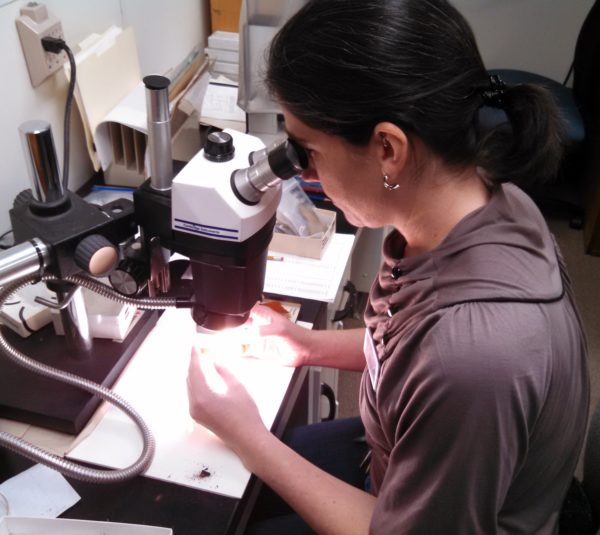
Lindsay analyzing sherd under the microscope.
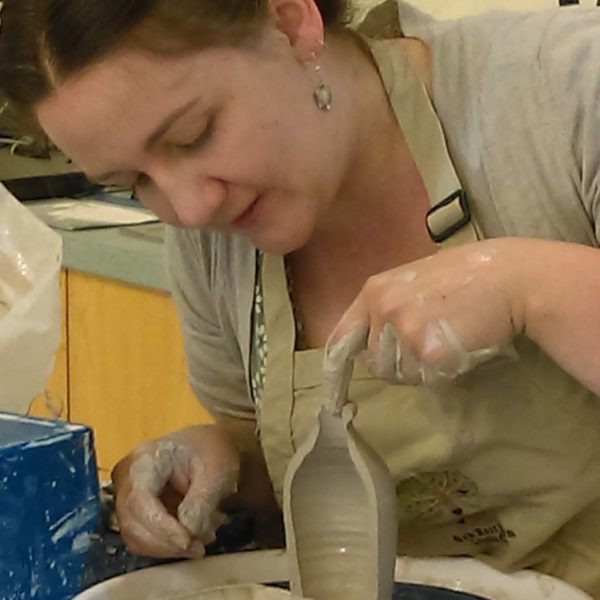
Brenda at a pottery wheel illustrating throwing techniques. Maybe next year we’ll bring a wheel to St. Charles?
Lindsay Bloch, Ceramic Technology Lab, Florida Museum of Natural History
Brenda Hornsby Heindl, Ceramics Department, Jeffrey S. Evans and Associates, Liberty Stoneware
#SHA2018 Session: How to Advocate for Archaeological Preservation in the New Political Climate
Want to Learn How to Advocate for the Preservation of Historical Archaeological Sites in the Era of Trump? Be Sure to Participate in the Following Interactive Session at the 2018 Society for Historical Archaeology Annual Meeting, New Orleans:
If You Are Not At the Table You Are On The Menu:
How to Be an Advocate for Historical Archaeology in Today’s Political Environment.
Facilitated by Marion Werkheiser, J.D. and Terry H. Klein, M.A., RPA.
Thursday, January 4th, 8:00-10:00 AM, Studio 7
(check final program to confirm session location and time)
Given today’s political environment, we must all be advocates for historical archaeology. If we are not fully engaged in the political process, then we must live with the consequences resulting from our inaction. In this working session, you will learn the ins and outs of being an advocate for historical archaeology. After a review of the current threats to government-supported and mandated historical archaeology in the United States, we will break into small groups to discuss:
· How and where should you meet your Congressional and state representatives, and federal and state agencies?
· How do you convey the value of historical archaeology in a way they will understand and appreciate?
· How can you partner with others to promote the value of historical archaeology to government decision-makers?
Each group will be facilitated by an expert in archaeological advocacy. You will also receive a package of materials that will help you in your future advocacy efforts.
So you’re considering a large-scale public archaeology event…
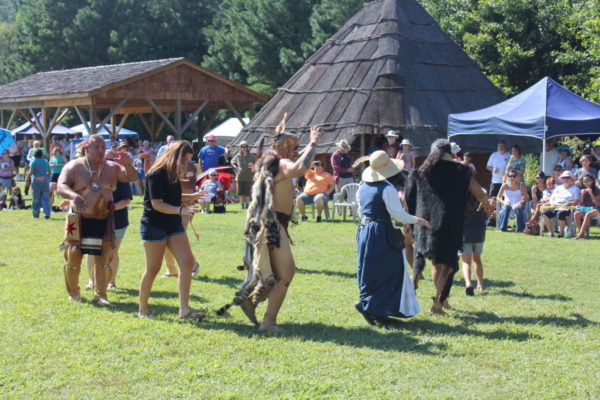
Warriors of AniKituhwa engage audience in the bear dance (Photo by Jill Wall, Morganton News-Herald, 2017).
In 2017, the Exploring Joara Foundation (EJF) began the commemoration of the 450th anniversary of the meeting between the Spanish Juan Pardo expeditionary force and the local native people. It is also the 450th anniversary of the founding of Fort San Juan at Joara. The crowning jewel of an ambitious schedule of events was a large community festival. We are, however, a very small public archaeology foundation with a staff of two. While the August 5th event was successful and very well received by the regional community and our Native American tribal participants, there was a steep learning curve. For this post, I would like to offer some tips and considerations for those who may be planning a 1000+ participant event for the first time.
Stick to a Theme
Whether your event is a singular occurrence (as ours was) or part of new annual initiative, it’s difficult to cover all aspects of the archaeological heritage you’re highlighting well. Apply your undergrad term paper writing skills to laser focus your message to streamline event planning and support your organization’s mission. Inviting all the vendors and the reenactors and the skills experts might build your organization’s partnership list. However, together they may offer a muddled message that will confuse an audience unused to an archaeology festival in the first place. These early planning processes will ensure all the time and resources spent on the event will produce the maximum amount of benefit for you, your partners, and the community.
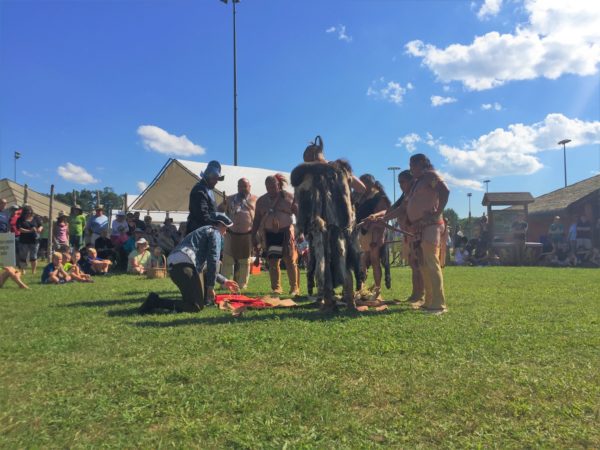
Reenacted presentation of gifts by Juan Pardo to Joarans (Photo by author, 2017).
For example, while we did share the Berry Site story and excavations, we chose to commemorate the events of 1567 by providing a platform for modern descendant tribal communities to share their stories and experiences. The goal was to further EJF’s public outreach mission. In addition to artifacts and archaeology-themed children’s activities, the event included a reenactment of Juan Pardo meeting the chiefs of Joara (executed by Mark Menendez, the Men of Menéndez, the Jager Companie von Roeder reenactors, and the Eastern Band of Cherokee’s Warriors of AnniKituhwa), and performances by a North Carolina intertribal dance troupe.
Most of the event’s vendors were from North and South Carolina tribal communities. Altogether, we had representatives from six of North Carolina’s eight state recognized tribes (Coharie, Eastern Band of Cherokee, Haliwa-Saponi, Lumbee, Sappony, and Waccamaw-Siouan). We also invited our long time partners from the Catawba Nation of South Carolina. The Catawba historically inhabited the Catawba River valley of North Carolina and are a descendant community of the Mississippian Joarans. Visitors raved about the traditional crafts, the informative interactions, and the historical and modern powwow-style dancing. We presented a tangible, accessible path between the data and living cultures.
Consideration of Committees and Community Partners
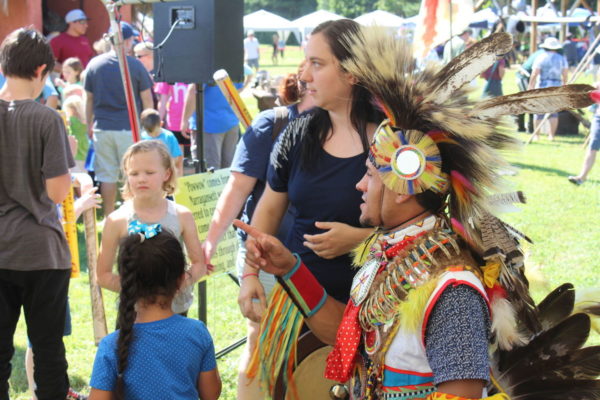
NC Intertribal Dance troupe performer answers visitor’s questions (Photo by Jill Wall, Morganton News-Herald, 2017).
Planning should not rest on the shoulders of one or two people. Other archaeologists, historians, state, and education folk are brilliant contributors but they are not necessarily local logistics experts. Balance is key for large-scope events. In a just-shy-of-too-late stroke of genius, we reached out to the City of Morganton Main Street Department. Their experienced festival and event staff connected us to food vendors, free access to city tents, tables, and chairs, and a borrowed sound system. This help saved us time and a great deal of money. Our work has complimented the city’s and county’s own marketing efforts in the past and they were eager to help with this new style of event. The local county tourism office also awarded us a marketing grant. Even the mayor called to ask if he could open the event. Don’t overlook the resources and enthusiastic staff of your local governments.
Timing is Everything
Be sure and give yourself plenty of time to allow all these wonderful partnership and committees to function properly. Close to 2,000 people came out to our event, but there could have been more. Event planning and performer outreach took longer than expected, which delayed marketing efforts. If our committees were better employed, then the multitasking would have been more efficient. Do yourself a favor and start actively working on your event at least a year before. While there will always be stress in the weeks leading up to a large event, it won’t be a “will it/won’t it happen at all” sort of stress if staffing and scheduling are effective.
In Conclusion
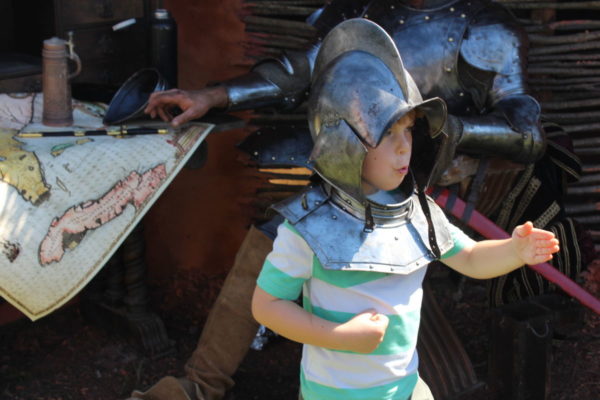
Newest Spanish recruit (Photo by Jill Wall, Morganton News-Herald, 2017).
Large scale events can be a very powerful method of sharing archaeology with the public. However, as many archaeologists are not event planners, the prospect of a festival may be intimidating. Relying on a wide variety of archaeological and non-archaeological partners and providing plenty of planning time helps. Planners should also take special consideration of the message. Make sure it rings clear even to those in the community simply looking forward to a new opportunity to get funnel cake. A successful event, like our 450th Fest, will bring more attention to and participation in your regular efforts and strengthen bonds with familiar and new community partners, making the whole process worthwhile.
Have you planned a very large public outreach event before? What did I miss? What other helpful suggestions do you have for event logistics, marketing, or message?
Melissa A Timo, EJF Staff Archaeologist
Wall, Lisa
2017 Celebrating the 450th Anniversary of Joara. News-Herald 5 August. Morganton, NC. <http://www.morganton.com/gallery/celebrating-the-th-anniversary-of-joara/collection_641540b0-7a32-11e7-a293-3f92fdb9950e.html>. Accessed 6 October 2017.
New Thematic Issue of Historical Archaeology: The Mardi Gras Shipwreck Project
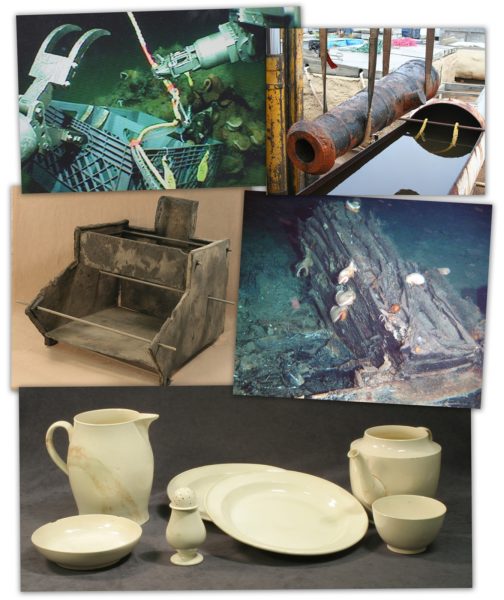
During the summer of 2007, detailed mapping and archaeological excavations were conducted at the Mardi Gras Shipwreck, the remains of an unidentified, wooden-hulled sailing vessel. Located in 4,000 feet of water 40 miles off the Louisiana coast, the Mardi Gras Shipwreck Project was considered at that time to be the deepest archaeological excavation ever conducted. The shipwreck itself is an amazing site with an artifact assemblage dating to the first decades of the 19th century. In the latest thematic issue of Historical Archaeology, the story of this project from its genesis as a Federal regulatory enforcement action to the reinterpretation of the data is provided. SHA members can access these articles online here: https://sha.org/secure/historical-archaeology/
Introductory articles describe the site’s discovery, and the field methods, tools, and technology needed for excavation in deep water, and provide an overview of the Gulf of Mexico’s unique and fascinating history at the time the ship slipped beneath the waves. Subsequent articles describe the material culture identified at this site including ceramics and bottles, a ship’s stove, firearms and cannon, navigational equipment, and the techniques employed to conserve recovered artifacts. Other articles describe the public outreach and documentary film production that took place in support of the project. Finally, the concluding article examines additional artifacts and site formation processes, and provides a new interpretation of the Mardi Gras Shipwreck. The paper titles include:
Introduction: The Mardi Gras Shipwreck Project: The Story of an Early Nineteenth-Century Wooden-Hulled Sailing Ship
Christopher E. Horrell, Amy A. Borgens Pages 323–328
The Mardi Gras Shipwreck Project: Overview of Methods and Tools
Jack B. Irion Pages 329–336
Mercantilism, Warfare, or Privateering? Providing the Historical Context for the Mardi Gras Shipwreck Site
Melanie Damour Pages 337–350
Land, Ho! Maritime Navigation through the Early Nineteenth Century as Represented by the Mardi Gras Shipwreck
Dave Ball Pages 351–358
Analysis of the Mardi Gras Shipwreck Ship’s Stove
Christopher E. Horrell Pages 359–378
The Glass and Ceramic Assemblage of the Mardi Gras Shipwreck
Ben Ford Pages 379–391
Artillery and Arms from the Mardi Gras Shipwreck
Amy A. Borgens Pages 392–409
The Conservation Research Laboratory and Conservation of Artifacts from the Mardi Gras Shipwreck Project
Helen Dewolf Pages 410–417
Lights, Camera … Shipwreck!?! Multimedia at Four Thousand Feet
Kimberly L. Faulk, Rick Allen Pages 418–424
Deep Thoughts: A Look at Public Access to Deepwater Sites through the Mardi Gras Shipwreck
Della A. Scott-Ireton Pages 425–432
The Mardi Gras Shipwreck Project: A Final Overview with New Perspectives
Christopher E. Horrell, Amy A. Borgens Pages 433–450
Memorial: George Robert Fischer (1937–2016)
Russell K. Skowronek Pages 451–461




Pingback: WAC May 2012 eNewsletter – Volume 40 – World Archaeology Congress